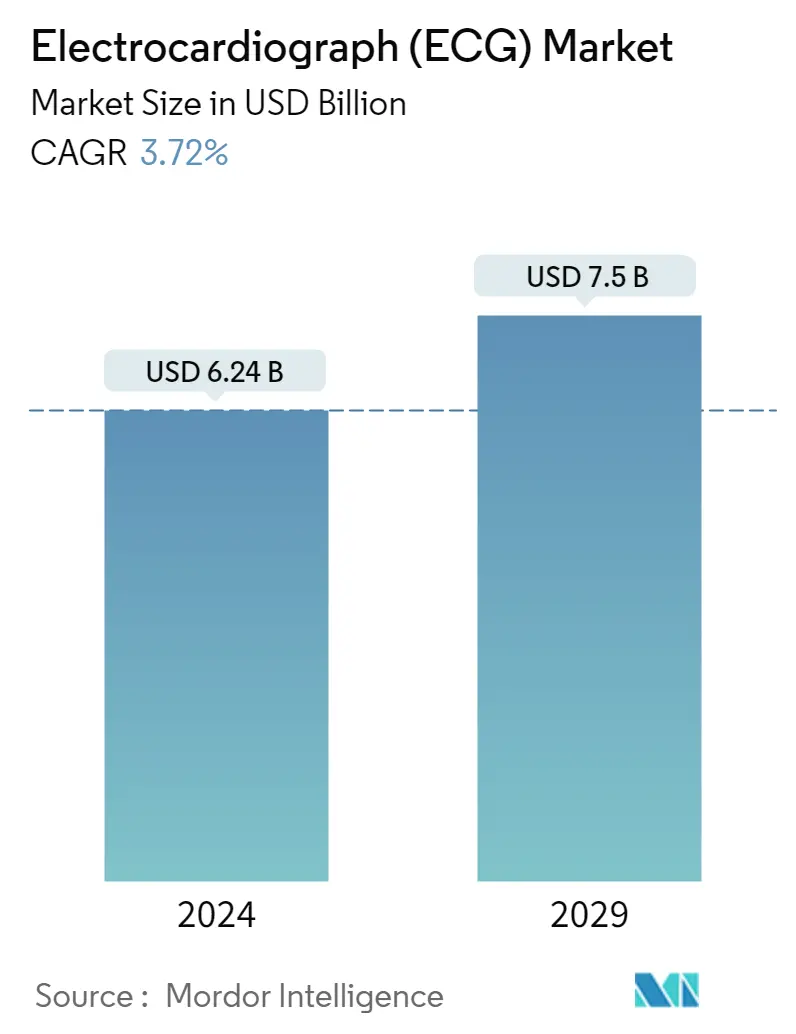Market Size of Electrocardiograph (ECG) Industry

| Study Period | 2019 - 2029 |
| Market Size (2024) | USD 6.24 Billion |
| Market Size (2029) | USD 7.50 Billion |
| CAGR (2024 - 2029) | 3.72 % |
| Fastest Growing Market | Asia Pacific |
| Largest Market | North America |
Major Players
*Disclaimer: Major Players sorted in no particular order |
Electrocardiograph (ECG) Market Analysis
The Electrocardiograph Market size is estimated at USD 6.24 billion in 2024, and is expected to reach USD 7.5 billion by 2029, growing at a CAGR of 3.72% during the forecast period (2024-2029).
The COVID-19 pandemic impacted the production of ECG devices. Furthermore, the delay of elective procedures due to COVID-19-related measures had adversely affected the ECG market, especially in 2020. On the other hand, COVID-19 can negatively impact the cardiovascular system and lead to abnormal ECG findings. For instance, according to the report titled 'Electrocardiographic manifestations of COVID-19' published in March 2021, COVID-19 can negatively impact the cardiovascular system and lead to abnormal ECG findings, which may be due to cytokine storm, hypoxic injury, electrolyte abnormalities, plaque rupture, coronary spasm, microthrombi, as well as direct endothelial or myocardial injury. This increase in the cases of cardiovascular complications due to COVID-19 may increase the diagnostic testing with ECG, which helps in the increased usage of ECG and augment the growth of the ECG market. However, the benefits of ECG help in the growth of the market during the pandemic. For instance, according to the study titled 'Electrocardiographic Changes in COVID-19 Patients: A Hospital-based Descriptive Study' published in January 2022, Patients with COVID-19 showed anomalies in their ECGs including ischemia alterations, rate, rhythm, and conduction problems. ECG is a straightforward, noninvasive test that can be used at the bedside to aid in the early diagnosis and management of cardiac damage in the face of the COVID-19 pandemic and limited healthcare resources. These advantages and easy access to ECG in hospitals and emergency care during COVID-19 showed a significant impact on the growth of the ECG market in the COVID-19 pandemic.
The market is expected to grow due to the increasing cases of cardiovascular diseases and the rising aging population. The increase in the incidence and prevalence of cardiovascular diseases across different age groups is primarily due to stressful work conditions, sedentary lifestyles, growing consumption of tobacco, alcohol, and substance abuse, and the growing geriatric population, and these factors are anticipated to have a positive impact on the growth of the ECG market during the forecast period of the study. According to the research study titled 'Global epidemiology of atrial fibrillation: An increasing epidemic and public health challenge' published in January 2020, the most common cardiac arrhythmia is atrial fibrillation, which is a major risk factor for ischemic stroke and causes an enormous economic burden as well as morbidity and mortality. Further, as per the same source, it is estimated that atrial fibrillation would affect 6-12 million people in the United States by 2050, while it will affect 17.9 million people by 2060. This data shows a significant prevalence of atrial fibrillation which can be diagnosed using ECG. Thus, the ECG market is anticipated to have a significant impact on the forecast period.
Another growth-driven factor is increased usage of remote monitoring devices and rapid technology advancements. For instance, in September 2020, the United States Food and Drug Administration (FDA) approved Samsung's electrocardiogram (ECG) monitoring app, when connected to a compatible Galaxy watch, the ECG monitor in the watch monitors a user's heart rhythm and scan for signs of irregularities or indications of atrial fibrillation (AFib). Furthermore, in a study titled 'A Study on Arrhythmia via ECG Signal Classification Using the Convolutional Neural Network', published in January 2021, machine learning and deep learning network have also been commonly used in the assisted diagnosis of heart disease based on ECG signals. These advanced methods in the ECG are expected to complement the growth of the market over the forecast period.
However, the expensive instrumentation and maintenance, along with complex reimbursement policies act as the factors restraining the growth of the ECG market.
Electrocardiograph (ECG) Industry Segmentation
As per the scope of the report, an electrocardiograph (ECG) is one of the simplest and fastest tests used to evaluate the heart. Electrodes (small, plastic patches that stick to the skin) are placed at certain spots on the chest, arms, and legs. These electrodes are connected to an ECG machine by lead wires. The electrical activity of the heart is then measured, interpreted, and printed out. The Electrocardiograph (ECG) Market is segmented by Product (Rest ECG Systems, Stress ECG Systems, Holter ECG Systems, Event Recorders, and Others), Technology (Portable ECG Systems and Wireless ECG Systems), Lead Type (Single Lead ECG, 3-6 Lead ECG, and 12 Lead), End User (Home-Based Users, Hospitals, and Other End Users), and Geography (North America, Europe, Asia-Pacific, Middle East and Africa and South America). The market report also covers the estimated market sizes and trends for 17 different countries across major regions globally. The report offers the value (in USD million) for the above segments.
| By Product | |
| Rest ECG Systems | |
| Stress ECG Systems | |
| Holter ECG Systems | |
| Event Recorders | |
| Others |
| By Technology | |
| Portable ECG Systems | |
| Wireless ECG Systems |
| By Lead Type | |
| Single Lead ECG | |
| 3-6 Lead ECG | |
| 12 Lead ECG |
| By End Users | |
| Home-Based Users | |
| Hospitals | |
| Other End Users |
| Geography | ||||||||
| ||||||||
| ||||||||
| ||||||||
| ||||||||
|
Electrocardiograph (ECG) Market Size Summary
The electrocardiograph (ECG) market is poised for growth, driven by the increasing prevalence of cardiovascular diseases and the aging population. The market's expansion is supported by the rising incidence of conditions such as atrial fibrillation, which poses significant health risks and economic burdens. The COVID-19 pandemic, while initially disrupting production and delaying procedures, ultimately highlighted the importance of ECGs in diagnosing cardiovascular complications associated with the virus. The pandemic underscored the utility of ECGs as a noninvasive, bedside diagnostic tool, thereby boosting their adoption. Additionally, advancements in remote monitoring devices and technology, such as FDA-approved ECG monitoring apps and machine learning applications, are expected to further propel market growth. However, challenges such as high costs and complex reimbursement policies may hinder progress.
North America leads the ECG market, driven by a well-developed healthcare infrastructure and a growing burden of cardiovascular diseases. The increasing elderly population in the United States necessitates effective detection and diagnosis of cardiac conditions, supporting market growth. Key players in the region are innovating and forming strategic partnerships to enhance their product offerings. The market remains fragmented, with several global companies competing, including General Electric Company, Koninklijke Philips N.V., and NIHON KOHDEN CORPORATION. Recent product launches, such as AliveCor's KardiaMobile Card and Philips' at-home 12-lead ECG solution, reflect the ongoing innovation and competitive dynamics within the market. These developments, coupled with collaborations and technological advancements, are expected to sustain the ECG market's growth trajectory over the forecast period.
Electrocardiograph (ECG) Market Size - Table of Contents
-
1. MARKET DYNAMICS
-
1.1 Market Overview
-
1.2 Market Drivers
-
1.2.1 Increasing Cases of Cardiovascular Diseases
-
1.2.2 Rising Aging Population Has High Risk of Cardiac Disease
-
1.2.3 Increasing Usage of Remote Monitoring Device
-
1.2.4 Rapid Technological Advancements
-
-
1.3 Market Restraints
-
1.3.1 Expensive Instrument and Maintenance
-
1.3.2 Complex Reimbursement Policies
-
-
1.4 Porter's Five Force Analysis
-
1.4.1 Threat of New Entrants
-
1.4.2 Bargaining Power of Buyers/Consumers
-
1.4.3 Bargaining Power of Suppliers
-
1.4.4 Threat of Substitute Products
-
1.4.5 Intensity of Competitive Rivalry
-
-
-
2. MARKET SEGMENTATION (Market Size by Value - USD million)
-
2.1 By Product
-
2.1.1 Rest ECG Systems
-
2.1.2 Stress ECG Systems
-
2.1.3 Holter ECG Systems
-
2.1.4 Event Recorders
-
2.1.5 Others
-
-
2.2 By Technology
-
2.2.1 Portable ECG Systems
-
2.2.2 Wireless ECG Systems
-
-
2.3 By Lead Type
-
2.3.1 Single Lead ECG
-
2.3.2 3-6 Lead ECG
-
2.3.3 12 Lead ECG
-
-
2.4 By End Users
-
2.4.1 Home-Based Users
-
2.4.2 Hospitals
-
2.4.3 Other End Users
-
-
2.5 Geography
-
2.5.1 North America
-
2.5.1.1 United States
-
2.5.1.2 Canada
-
2.5.1.3 Mexico
-
-
2.5.2 Europe
-
2.5.2.1 Germany
-
2.5.2.2 United Kingdom
-
2.5.2.3 France
-
2.5.2.4 Italy
-
2.5.2.5 Spain
-
2.5.2.6 Rest of Europe
-
-
2.5.3 Asia-Pacific
-
2.5.3.1 China
-
2.5.3.2 Japan
-
2.5.3.3 India
-
2.5.3.4 Australia
-
2.5.3.5 South Korea
-
2.5.3.6 Rest of Asia-Pacific
-
-
2.5.4 Middle East and Africa
-
2.5.4.1 GCC
-
2.5.4.2 South Africa
-
2.5.4.3 Rest of Middle East and Africa
-
-
2.5.5 South America
-
2.5.5.1 Brazil
-
2.5.5.2 Argentina
-
2.5.5.3 Rest of South America
-
-
-
Electrocardiograph (ECG) Market Size FAQs
How big is the Electrocardiograph (ECG) Market?
The Electrocardiograph (ECG) Market size is expected to reach USD 6.24 billion in 2024 and grow at a CAGR of 3.72% to reach USD 7.50 billion by 2029.
What is the current Electrocardiograph (ECG) Market size?
In 2024, the Electrocardiograph (ECG) Market size is expected to reach USD 6.24 billion.

